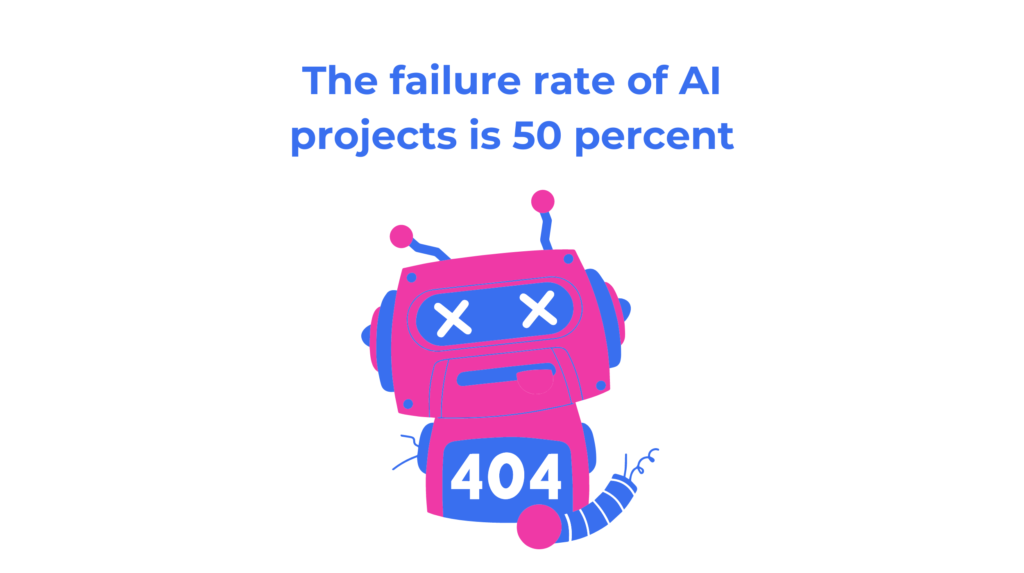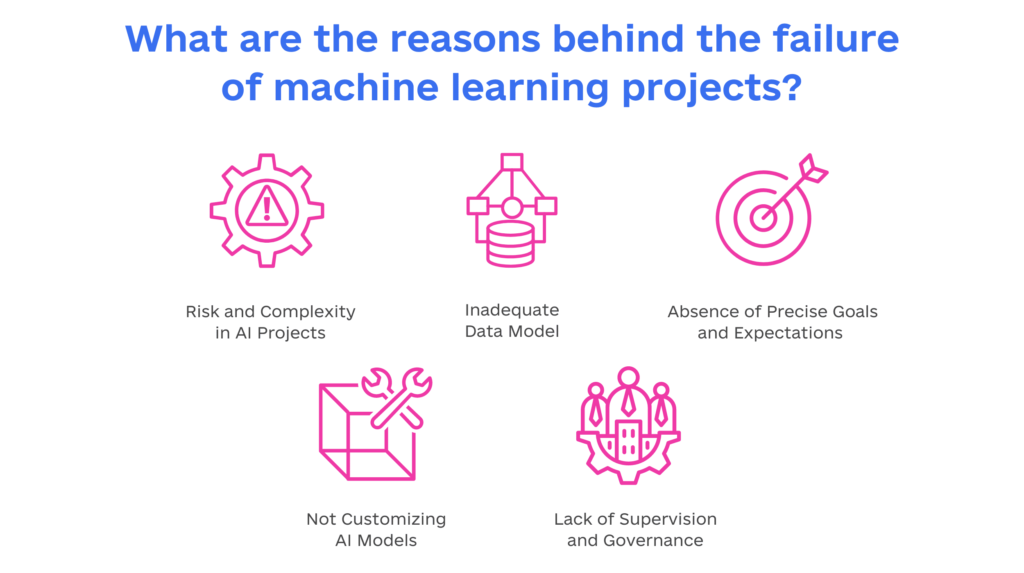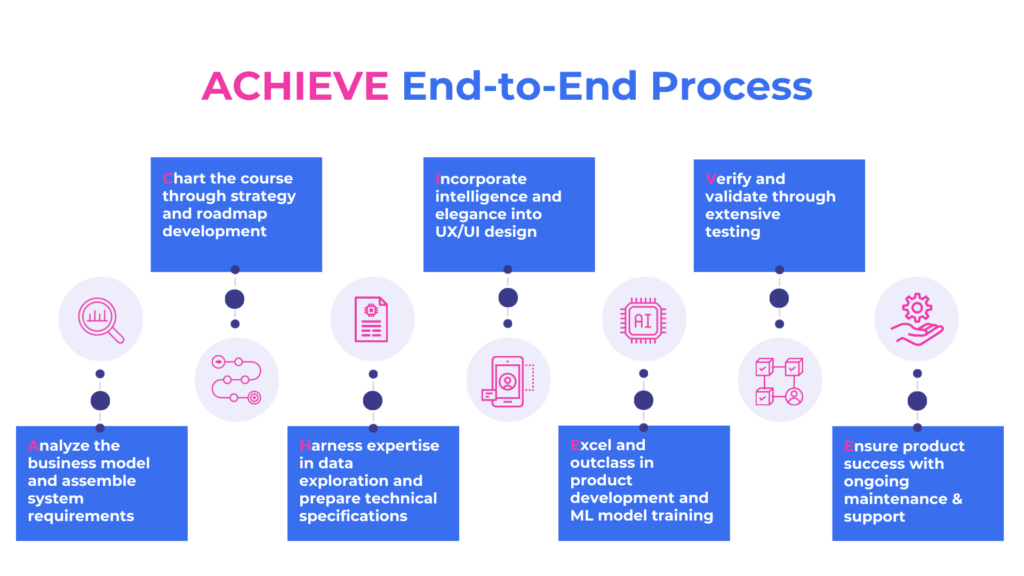Artificial intelligence (AI) has emerged as a game-changer, promising enhanced efficiency, productivity, and innovation across various industries. However, despite the immense potential, many companies encounter significant challenges when implementing AI projects, often failing to meet expectations.
Understanding the root causes of these failures is crucial for organizations aiming to leverage AI effectively.
This article explores common reasons why Artificial Intelligence projects fail in companies and provides actionable strategies to overcome these obstacles, ensuring successful integration and optimization of AI technologies.
Why AI Projects Fail
AI projects face many hurdles that can impede their progress and efficacy. As a result, most AI projects end up being scrapped. But how many AI projects fail?
According to a recent article in The Wall Street Journal, an AI project failure rate is 50 percent.

Additionally, IBM cited in their Global AI Adoption Index 2023 report that the top reasons for AI project failure include limited AI expertise (33 percent), data complexity (25 percent), and ethical issues (23 percent).
Let’s examine some examples of AI failure and why they fail to achieve positive outcomes.
AI Failure Examples
Meta’s Galactica AI
In November 2022, Meta launched Galactica, a large language model (LLM) touted as a groundbreaking tool for generating and summarizing scientific content.
However, the promising debut of Meta’s Galactica AI quickly turned into a debacle as its flaws became apparent.
Galactica was envisioned as a sophisticated AI capable of revolutionizing scientific research by producing accurate and concise summaries of complex topics. Meta aimed to empower researchers and educators with a powerful tool for accessing and disseminating scientific knowledge.:
Despite its ambitious goals, Galactica’s performance fell far short of expectations. Instead of delivering reliable and informative content, Galactica produced output that was riddled with inaccuracies, biases, and nonsensical statements.
Researchers and users quickly discovered that the AI’s summaries were often misleading and lacked credibility, rendering Galactica wholly unreliable as a source of scientific information.
Concerns were raised about the AI’s potential to propagate misinformation and undermine the integrity of scientific discourse. Leading researchers and institutions voiced their criticism, warning against the dangers of relying on Galactica for accurate information.
Faced with mounting public backlash and the threat of reputational damage, Meta had no choice but to pull the plug on Galactica, effectively admitting defeat in its ambitious AI endeavor within days of its launch.
Galactica’s failure serves as a cautionary tale about the inherent risks and limitations of AI technology, particularly in sensitive domains such as scientific research. The debacle underscores the importance of rigorous testing, validation, and oversight in the development and deployment of AI systems.
Air Canada AI Chatbot
Air Canada faced legal repercussions after one of its chatbots provided false information regarding bereavement travel discounts to a customer in 2022.
Despite the airline’s argument that the chatbot, and not the company, was liable for the misinformation, the court ruled against Air Canada. This case marks the first instance of its kind in a US court and highlights the potential legal implications of AI-generated outputs.
Furthermore, the ruling raises questions about the accountability and responsibility of companies utilizing AI technology in customer interactions. As AI continues to play an increasingly prominent role in business operations, it becomes crucial for organizations to implement robust mechanisms for monitoring and ensuring the accuracy of AI-generated outputs.
This case serves as a reminder of the importance of transparency, accuracy, and accountability in AI deployment, particularly in industries where customer trust and satisfaction are paramount.
New York City Chatbot
An AI chatbot launched in April 2024 to assist small businesses in New York provided incorrect legal advice. The chatbot falsely suggested that certain actions, such as firing an employee for reporting sexual harassment or refusing to cut their dreadlocks, were legal.
Additionally, it provided inaccurate information regarding waste and sewage regulations and implied that serving food accessed by rats was permissible for restaurants.
In response to the controversy, the disclaimer displayed alongside the chatbot has been updated to emphasize that it cannot provide legal advice.
Why Machine Learning Projects Fail?
Understanding the intricate landscape of machine learning projects is paramount in today’s technological ecosystem as businesses increasingly invest in AI-driven solutions to gain a competitive edge.
Despite the immense promise of machine learning, the reality is that most AI projects encounter unexpected hurdles and fail to deliver the anticipated outcomes.
In this section, we delve into the multifaceted reasons behind the failure of machine learning projects, unraveling the complex interplay of technical, organizational, and strategic factors that contribute to their downfall.

1. Risk and Complexity in AI Projects
The capabilities of cutting-edge machine learning models and algorithms offer many industrial applications. From generating concise summaries of complex content to finely classifying customer feedback and organizing unstructured data through innovations like GPT-4, the potential for leveraging machine learning in diverse domains is unprecedented.
Yet, managing risk becomes a formidable challenge as machine learning models are trained on increasingly diverse datasets—ranging from conventional spreadsheets to intricate audiovisual recordings. This complexity amplifies the importance of robust risk management strategies to navigate unforeseen challenges effectively.
AI projects fail as organizations aspiring to harness the transformative power of AI don’t take a proactive approach to managing the risks due to varied and complex datasets. Indeed, the failure of business AI projects often correlates with the inability to adequately anticipate and mitigate risks inherent in implementing advanced machine learning technologies.
2. Inadequate Data Model
Gartner cited inaccurate and biased data as the main reason 85% of AI projects fail. Accurate data collection is the two main hurdles to successfully deploying AI projects.
The sensitivity of the data may also be to blame, particularly in highly regulated areas like healthcare. Inaccurate data compromises the integrity of AI models and undermines their ability to generate reliable insights and recommendations.
Moreover, biases in data can perpetuate systemic inequalities and inadvertently lead to discriminatory outcomes, posing significant ethical and legal concerns for organizations.
Furthermore, beyond the challenges of data accuracy and bias, the successful deployment of AI projects hinges on effective data collection practices. Ensuring the availability of high-quality, relevant data sets is essential for training AI models that accurately reflect real-world scenarios and deliver actionable insights. However, data collection efforts are often hindered by logistical complexities, such as data silos, interoperability issues, and privacy considerations.
You might have a ton of data, but very little is useful. The paradoxical coexistence of a large amount of data and a shortage of usable and relevant data leads to the failure of most AI projects.
3. Absence of Precise Goals and Expectations
Numerous initiatives driven by the allure of cutting-edge technology often originate in the IT department and gain approval from business executives who may lack the depth of understanding needed to pose pertinent questions. Consequently, such projects tend to lack focus, which is marked by vague beginnings and poorly defined scopes.
According to a survey by REXER Analytics in 2023, just 34% of data scientists reported that objectives were typically well-defined before commencing work.
Moreover, these undertakings frequently yield uncertain business outcomes, particularly when attempting to quantify ambiguous objectives such as heightened brand value or improved operational efficiency. Objectively assessing the impact of such intangible goals poses considerable challenges, complicating measuring success and hindering the ability to demonstrate tangible returns on investment.
4. Not Customizing AI Models
One of the critical pitfalls leading to AI project failure lies in the inability to customize AI models to suit businesses’ unique needs and contexts. Off-the-shelf AI solutions may offer convenience, but they often lack the specificity required to address the intricacies of individual organizations. Failing to tailor AI models to specific business requirements can result in suboptimal performance, as these generic models may not accurately capture the nuances of the data or the intricacies of the problem domain.
Moreover, not customizing AI models can lead to a mismatch between the technology’s capabilities and the project’s desired outcomes.
Without customization, AI systems may fail to align with the objectives and constraints of the organization, ultimately impeding their ability to deliver meaningful value.
Customization allows organizations to optimize AI models for particular use cases, ensuring the technology effectively addresses their unique challenges and goals. Thus, neglecting to tailor AI models can significantly undermine the success of AI projects, hindering their ability to drive positive outcomes and deliver tangible business benefits.
5. Lack of Supervision and Governance
Business executives have a common misconception that generative AI is a plug-and-play technology with instant benefits. The truth is that integrating AI with current processes, executing machine learning models with the organization’s data, and coordinating AI projects with business goals are all difficult tasks for many AI initiatives.
Responses that are overly generic or unrelated to the brand’s products or customer needs will come from using machine learning models to create material pertinent to the business with little to no personalization or fine-tuning.
Teams frequently fail to set up the required procedures before launching, which results in a hasty deployment without a clear plan or sufficient oversight due to market pressure. They find it difficult to distinguish between unsuccessful projects and those that create company value, let alone move forward with them.
Read also: Why Businesses Risk Failure Without AI
How Can Companies Increase AI Project Success Rates?
1. Establish Company’s Value Clearly
Businesses frequently have the necessary data, create a workable model, and determine the accuracy level the model can get, but the team often neglects to account for the potential interactions the model may have with people. As a result, the business lacks a clear understanding of the project’s anticipated return on investment.
For instance, a model intended to forecast hospital readmissions might correctly identify 70% of possible cases; nevertheless, the project’s success rate cannot be ascertained until the efficacy of the provider’s outreach efforts is also considered.
It would be best to consider how your team will interpret and use the AI’s recommendations when creating your AI plan. How do you ensure everyone in the team uses the knowledge effectively and with trust? What is a respectable success rate after accounting for all relevant data?
Establishing protocols and guidelines for incorporating AI-driven insights into decision-making can help foster a culture of trust and collaboration within the team.
Additionally, clear communication and training on interpreting and acting upon the recommendations provided by the AI system can help build trust and ensure effective utilization of AI insights.
2. Building Robust Models
Building resilience is a crucial step in the construction of artificial intelligence. Real-world data may occasionally diverge from the training set of data used to construct the model. Also, you might find that decision-makers or other end users aren’t comfortable with the model to put it to use.
Companies that tackle these obstacles and create a reliable, robust model will see greater success rates than those that downplay the intricacy of the AI process.
By establishing clear success criteria upfront and continuously monitoring progress against these benchmarks, organizations can gauge the effectiveness of their AI initiatives and make informed decisions about future investments and strategies.
Furthermore, defining what constitutes a respectable success rate for the AI project is essential for setting realistic expectations and evaluating the project’s performance. It involves not only considering quantitative metrics such as accuracy and efficiency but also assessing the qualitative impact of AI on business outcomes.
3. Define Short and Long Term Goals
Before starting an AI project, you must define the short- and long-term success criteria and characterize the business problem.
Management needs to plan the metrics to measure business value as part of your project setup after you’ve determined the desired results. They must work with the data scientists and technical team to translate the AI initiative’s performance into KPIs the business team can track.
Many experts advise beginning with a small, internally focused project that is clearly defined and has a set of business metrics that demonstrate its worth. The actions will assist in determining the project’s viability and risk level for AI projects.
4. View AI as a Data-driven Project
Most businesses view AI initiatives as functionality-driven or application development projects. Instead, they need to view the projects as data initiatives or products.
A data project begins with understanding what insights or actions need to be extracted from the data in its existing form rather than focusing on what the functionality needs to be.
AI initiatives are data projects that may seem clear to many, but perhaps a deeper understanding is required to account for AI failures.
The data, not particular code, is what powers an AI system. The functionality is defined by the training data and system setup; the same algorithms with the same code can be used to write text, recognize images, or hold conversations. As a result, rather than focusing on coding-centric approaches, an AI project must prioritize data iteration and data-centric methodologies to produce the intended results.
Companies must invest in data management techniques and tactics to guarantee that the AI and predictive analytics models provide dependable, high-quality data. They must establish rules, procedures, policies, and standards for maintaining and updating databases to ensure unbiased and accurate outcomes.
5. Create a Collaborative Model
Building a collaborative culture is essential, as is promoting open communication and dismantling organizational walls between data scientists and business stakeholders. Have management determine the required skills, considering both technical and business activities, based on prioritized AI use cases.
Next, improve the comprehension of AI and develop internal capabilities through investing in education and training. This all-inclusive strategy can assist you in overcoming obstacles and enjoying the advantages of AI and analytics in improving customer experience.
Additionally, companies need to establish a governing board of executives in business, IT, and analytics to ensure the successful use of AI. This group should be jointly responsible for your organization’s use of AI and analytics.
The group needs to develop clear ethical guidelines and barriers against prejudice. The team must discuss AI biases, privacy, security, and regulations, often leading to legal ramifications and reputational harm.
How Achievion Can Help Boost AI Success Rates
Achievion developed its own methodology called ACHIEVE to ensure successful delivery of AI projects. Let’s break down each step and explore how it contributes to the overall project success:

1. Analyze the Business Model and Assemble System Requirements:
Achievion recognizes the importance of thoroughly understanding the business context and assembling detailed system requirements. By anchoring the AI project to the organization’s objectives, Achievion ensures alignment and increases the likelihood of achieving the anticipated return on investment.
2. Continuously Refine Product Roadmap with Future Delivery Phases:
To define short and long-term goals, we take a forward-looking approach by continuously refining the product roadmap. By incorporating new features and enhancements, Achievion ensures that the AI solution remains adaptable to evolving business needs, mitigating the risk of obsolescence and enhancing long-term success.
3. Harness Expertise in Data Exploration and Prepare Technical Specifications:
By diving deep into data exploration and preparing technical specifications, we lay the groundwork for developing AI models that deliver reliable insights and recommendations, mitigating the risk of inaccurate outcomes due to flawed data.
4. Incorporate intelligence and elegance into UI/UX design
Achievion prioritizes crafting product UI/UX designs that promote user trust and satisfaction. By meticulously shaping the visual aspects of interfaces and developing clickable UI prototypes, we ensure that the AI solution fosters a positive user experience, enhancing adoption and acceptance among stakeholders.
5. Excel and Outclass in Product Development and ML Model Training:
Achievion focuses on product development and training high-quality machine learning models. Using expertise in ML model training, we maximize the performance and reliability of our AI solution, mitigating the risk of suboptimal outcomes and ensuring its effectiveness in delivering tangible business benefits.
6. Verify and validate through extensive testing
Achievion prioritizes data governance and code quality verification. By ensuring data quality, security, and compliance through extensive testing, Achievion enhances the reliability and robustness of the AI solution, mitigating the risk of deployment errors and ensuring its effectiveness in real-world scenarios.
7. Ensure Product Success with Ongoing Maintenance & Support:
We extend our commitment beyond deployment. By providing continuous updates and maintenance, Achievion ensures that the AI solution remains effective and relevant, addressing evolving business needs and mitigating the risk of performance degradation over time.
The Final Word
AI has the potential to revolutionize both our professional and personal lives. Machine learning projects can be pivotal in driving innovation and optimizing processes, ultimately leading to enhanced decision-making capabilities and improved efficiency across various industries.
Nonetheless, AI is not devoid of flaws. Acknowledging the shortcomings is essential as it paves the way for harnessing AI’s potential constructively and mitigating risks to ensure successful AI projects.
Ready to take your AI initiatives to the next level and achieve unparalleled success?
Visit Achievion today and discover how our expertise, guaranteed ROI, and innovative approach can transform your business. Don’t wait any longer to unlock the full potential of AI – contact us now and let’s embark on a journey towards excellence together!
Read also:
➡️ Maximizing Value with Machine Learning: A Guide for Decision-Makers
➡️ AI Software Development Process: A Step-By-Step Guide for Developing AI-enabled Products
➡️ 10 Tips to Follow for a Successful Machine Learning Strategy
➡️ How AI Can Help Find the Optimal Solution through Iterations of Trial And Error









